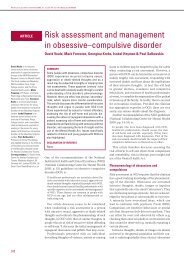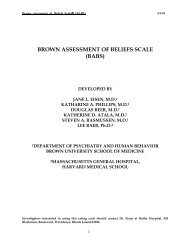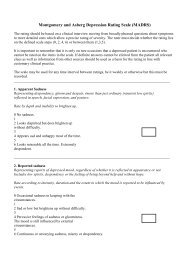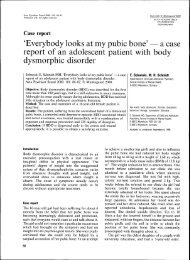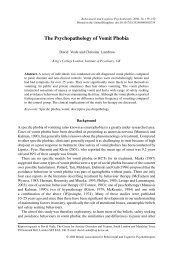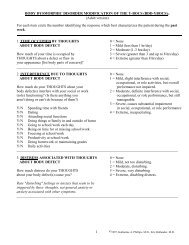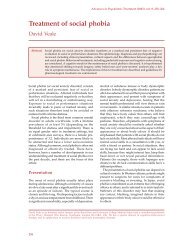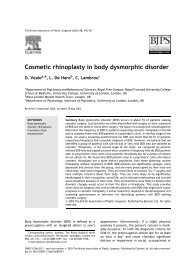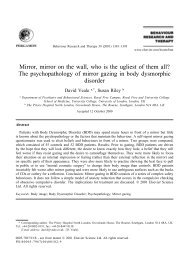Cognitive behaviour therapy for a specific phobia of vomiting
Cognitive behaviour therapy for a specific phobia of vomiting
Cognitive behaviour therapy for a specific phobia of vomiting
You also want an ePaper? Increase the reach of your titles
YUMPU automatically turns print PDFs into web optimized ePapers that Google loves.
274 D. VealeTable 1. Key criteria <strong>for</strong> <strong>specific</strong> <strong>phobia</strong> <strong>of</strong> <strong>vomiting</strong>(a) Marked and persistent fear <strong>of</strong> <strong>vomiting</strong> that is excessive or unreasonable, cued by the presence <strong>of</strong>vomit or anticipation <strong>of</strong> <strong>vomiting</strong>.(b) Exposure to cues related to <strong>vomiting</strong> almost invariably provokes an immediate anxiety response,which may take the <strong>for</strong>m <strong>of</strong> a situationally bound or situationally pre-disposed panic attack.(c) The person recognizes that the fear <strong>of</strong> <strong>vomiting</strong> is excessive or unreasonable.(d) Phobic situations related to <strong>vomiting</strong> are avoided or else endured with intense anxiety or distress.(e) The avoidance, anxious anticipation, or distress interferes significantly with the person’s normalroutine, occupational (or academic) functioning, or social activities or relationships, or there ismarked distress about having the <strong>phobia</strong>.I first discuss the differential diagnosis <strong>of</strong> SPOV from other anxiety disorders and anorexianervosa and how they may be comorbid. It is particularly important to note the onset <strong>of</strong> acomorbid diagnosis and its functional relationship to SPOV.Hypochondriacal disorder (health anxiety)People with hypochondriacal disorder are concerned with the fear <strong>of</strong> being ill (in which thefocus <strong>of</strong> a disease <strong>of</strong>ten varies over time) rather than <strong>vomiting</strong> per se. People with SPOV<strong>of</strong>ten have a significant degree <strong>of</strong> health anxiety in that they worry about infections or foodpoisoning that may cause them to vomit. Alternatively, they attribute the cause <strong>of</strong> nausea toa physical problem (e.g. irritable bowel syndrome, or middle ear disease) rather than anxiety.A diagnosis <strong>of</strong> a comorbid hypochondriacal disorder would be made if there were additionalfears <strong>of</strong> illness unrelated to <strong>vomiting</strong>.Obsessive–compulsive disorder (OCD)People with SPOV <strong>of</strong>ten per<strong>for</strong>m rituals or superstitious <strong>behaviour</strong>s to prevent <strong>vomiting</strong> andthese tend to develop after the SPOV. A comorbid diagnosis <strong>of</strong> OCD would be made if therewere additional obsessions and compulsions that are unrelated to rituals and an over-inflatedsense <strong>of</strong> influence over their ability to stop themselves or others <strong>vomiting</strong>.Panic disorderA diagnosis <strong>of</strong> panic disorder requires recurrent unexpected panic attacks with anticipatoryanxiety about further attacks. Sometimes the main fear <strong>of</strong> panic disorder is <strong>of</strong> <strong>vomiting</strong> whenfeeling nauseous and anxious (but this is usually in the context <strong>of</strong> other physiological sensationsand minimal avoidance <strong>of</strong> cues relating to <strong>vomiting</strong>). It is, however, still possible to have anadditional comorbid spontaneous panic attacks unrelated to a SPOV.Social <strong>phobia</strong>The majority <strong>of</strong> people with a SPOV are fearful <strong>of</strong> <strong>vomiting</strong> whether they are alone or in socialsituations (<strong>of</strong>ten equally). The embarrassment <strong>of</strong> <strong>vomiting</strong> in public may be an additionalburden <strong>for</strong> a person with a SPOV. Here the fear <strong>of</strong> others being critical <strong>of</strong> <strong>vomiting</strong> in public



